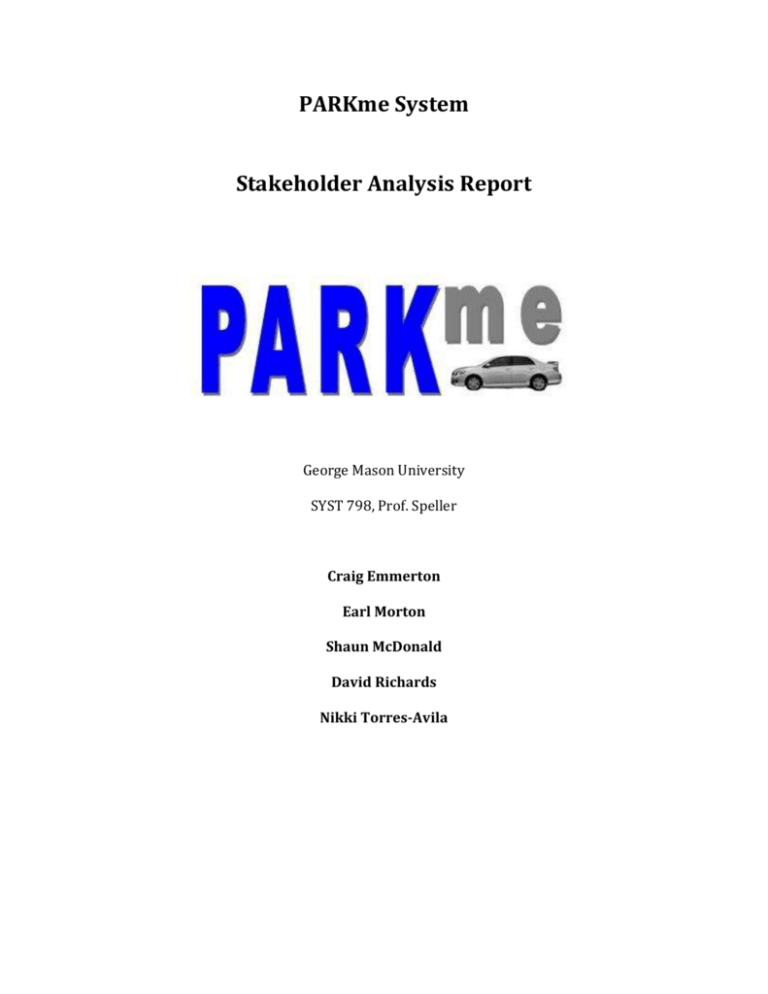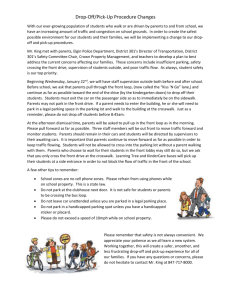Stakeholder Analysis Report - SEOR
advertisement

PARKme System Stakeholder Analysis Report George Mason University SYST 798, Prof. Speller Craig Emmerton Earl Morton Shaun McDonald David Richards Nikki Torres-Avila SYST 798 PARKme System Stakeholder Analysis Report Table of Contents 1.0 STAKEHOLDER IDENTIFICATION ....................................................................................... 3 1.1 End User ............................................................................................................................................... 3 1.2 GMU Administration........................................................................................................................ 3 1.3 GMU Police/Security ....................................................................................................................... 3 1.4 Project Manager ................................................................................................................................. 3 1.5 GMU Maintainer ............................................................................................................................... 3 1.6 Engineers.............................................................................................................................................. 4 1.7 Project Sponsors................................................................................................................................. 4 2.0 KEY STAKEHOLDER IDENTIFICATION ............................................................................ 4 3.0 NEED ANALYSIS AND VALUE MAPPING ........................................................................ 6 3.1 Use Cases ............................................................................................................................................. 6 3.1.1 Provide PARKme Services to Driver ....................................................................................... 6 3.1.2 Find Available Spaces ................................................................................................................. 6 3.1.3 Update Parking Availability ....................................................................................................... 7 3.1.4 Report Parking Violations ........................................................................................................... 8 3.1.5 Generate Parking Usage Report ................................................................................................. 9 3.1.6 Provide PARKme Maintenance .............................................................................................. 10 1.3.2 Value Mapping ............................................................................................................................ 11 1.3.3 Quality Function Deployment ................................................................................................. 13 2 SYST 798 PARKme System Stakeholder Analysis Report The purpose of this document is to identify and describe the stakeholders for the PARKme system. It addresses their influence, interests, and their interaction with the system. 1.0 STAKEHOLDER IDENTIFICATION 1.1 End User The end user is the person that interacts with the operational system. The end user obtains current parking availability of the different lots around the campus. The end users for the PARKme System are students, faculty, visitors, and administrative personnel from the GMU Campus. 1.2 GMU Administration These are the “Executive stakeholders.” Their role in the development of the system is to provide funding for the design, development, testing, installation, and maintenance of the system. They’re interested in improving the parking problem in the university on a commercial level. They will compile data from the system to continually improve the system. They will also be in charge of getting support/“buy-in” from the stakeholders involved. 1.3 GMU Police/Security The system notifies the university police of any parking violation. In the event that an unauthorized driver parked in a disabled area or in forbidden zones, a message will be sent for the police to take the appropriate action. 1.4 Project Manager The program manager manages the project development, interacts with the customer, and leads a team to produce the end-item with the available resources and within the constraints of time, cost, and performance/technology. Additional responsibilities include: Identifying, tracking, managing and resolving project issues Proactively disseminating project information to all stakeholders Identifying, managing, and mitigating project risk Ensuring that the solution is of acceptable quality Proactively managing scope to ensure that only what was agreed on is delivered, unless changes are approved through scope management Defining and collecting metrics to give a sense for how the project is progressing and whether the deliverables produced are acceptable 1.5 GMU Maintainer The system maintainer is in charge of conducting tests and repairs to ensure the effective performance of the system. Must be equipped with the appropriate skill set to be able to repair the system within the designated constraints. 3 SYST 798 PARKme System Stakeholder Analysis Report 1.6 Engineers They are the part of the team in charge of defining the system requirements, decomposing the system requirements down to sub-system levels, maintaining interfaces between subsystem and rest of system, integrating the system and define system-level testing. 1.7 Project Sponsors The sponsor for the PARKme system is Josh Cantor. Josh Cantor is the director of Parking and Transportation the GMU and represents the GMU administration. As director of Parking and Transportation, he has been assigned the task of improving the parking problem at GMU. 2.0 KEY STAKEHOLDER IDENTIFICATION To identify the key stakeholders for the PARKme System an Influence-Interest matrix was used. The interest-influence grid is a mapping tool developed by Imperial College London. A similar version of this mapping tool is widely used in the government and private industry. The level of influence and importance of each stakeholder was established. The level of interest was determined by how the stakeholder is affected by decisions or success of the project. In a similar way, the level of influence was determined by the power of a stakeholder to affect the success of the project. For example, the GMU administration has a high influence and interest on the system. While the campus police have a low interest on the development of the system, they will be affected positively upon its successful deployment. Stakeholder End User GMU Administration GMU Police GMU Maintainer Engineers developing/testing the system Project Manager Project Sponsors Influence H H L M H H H Table 1: Stakeholder Influence and Interest 4 Interest H H M H M H H SYST 798 PARKme System Stakeholder Analysis Report Figure 1: Stakeholder Influence vs. Interest Matrix After establishing each stakeholder influence and interest and plotting the stakeholder in the grid, each stakeholder, is found to belong to one of the following groups: Manage Closely Quadrant - High influence, interest stakeholders: End User, GMU Administration, Project Sponsors, and Project Manager. For this group of people we must put most of our efforts and fully engage them. Keep Satisfied Quadrant - High influence, less interest stakeholders: Engineers. Enough information must be provided in order to keep them satisfied. Keep Informed Quadrant - Low influence, high interest stakeholders: GMU Police, GMU Maintenance Personnel. They need to be kept informed adequately. Monitor Quadrant – Low influence, low interest stakeholder – They need to be observed closely but minimal effort is required. From the Influence - Interest Grid, the relative importance of each stakeholder was also established. The stakeholders are listed below in descending order of importance: End User Project Sponsors GMU Administration Project Manager GMU Maintenance Engineers GMU Police 5 SYST 798 PARKme System Stakeholder Analysis Report 3.0 NEED ANALYSIS AND VALUE MAPPING The translation of stakeholder needs is one of the most important tasks of system engineering. Understanding the needs is an iterative process that was refined during several stages as we defined the behavior of the PARKme System. The idea is to obtain a current and future vision for the system from each stakeholder perspective. Some of the techniques used to elicit stakeholder’s needs for the PARKme system include: interviews, use cases, and end user surveys. 3.1 Use Cases The use cases developed for the system intent to demonstrate how the system interacts with different users and actors. They constitute a set of actions that provide measurable value to the actor [1]. The follow sections provide a general description for each use case as well as the detailed use case narrative and respective use case diagram. 3.1.1 Provide PARKme Services to Driver The Provide PARKme Services to Driver super use case is composed by the following use cases: Determine User Preferences, Find Parking, and Update Parking Availability. Figure 2 presents the use case diagram for Provide PARKme Services to Driver super use case. Find Parking Determine User Preferences <<include>> Driver <<include> > Update parking Availability PARKme System Figure 2: Provide PARKme Services to Driver Use Case Diagram 3.1.2 Find Available Spaces The Find Available Spaces use case covers the interaction of the PARKme system with the driver. It starts with the arrival of the driver to the GMU parking lot and it ends with the driver parking at the desired location. Use Case: Find available spaces 6 SYST 798 PARKme System Stakeholder Analysis Report Goal In Context: Driver uses PARKme to find empty spaces close to desired location Scope: Level: PARKme System Sea Level Pre-Condition: PARKme is active Success End Condition: Driver parks in the desired location. Primary Actor: Driver: Uses PARKme Services 1 Driver arrives at the parking lot Main Success Scenario Actor Driver Action Description Driver approximates to PARKme System 2 PARKme PARKme determine user data 3 PARKme PARKme retrieves user preferences 4 5 Schedule: Priority: PARKme Driver Related Information Release 1.0 Must Super Use Case: Provide PARKme Services to Driver Trigger Event: Step PARKme provides a list of parking spaces based on user preferences Driver parks in the desired parking space 3.1.3 Update Parking Availability This use case is triggered by a change in a parking availability. It updates the parking database when a driver arrives or leaves a specific parking space. Use Case: Update Parking Availability PARKme updates parking Goal In Context: availability Scope: Level: PARKme System Sea Level Pre-Condition: PARKme is active Success End Condition: Driver keeps up to date parking availability Primary Actor: PARKme Trigger Event: Step A change in a parking availability occurs Main Success Scenario Actor Action Description 7 SYST 798 PARKme System Stakeholder Analysis Report 1 Driver Driver parks in parking space 2 PARKme PARKme detects the parking space is occupied 3 PARKme PARKme updates the state of the parking 4 5 6 Driver leaves parking space PARKme detects the parking space is empty PARKme updates the state of the parking Schedule: Priority: Driver PARKme PARKme Related Information Release 1.0 Must Super Use Case: Provide PARKme Services to Driver 3.1.4 Report Parking Violations The Report Parking Violations use case presents the interaction of the PARKme system with the campus police. It starts with the system’s detection that a driver parked in a nonauthorized zone and it ends with the campus police taking the appropriate action. Figure 3 presents the use case diagram for this use case. Report Parking Violations Campus Police PARKme System Figure 3: Report Parking Violations Use Case Diagram Use Case: Report Parking Violations Goal In Context: PARKme notifies campus police of parking violation Scope: Level: PARKme System Sea Level Pre-Condition: PARKme is active Success End Condition: Campus Police is notified a violation occurred Primary Actor: PARKme 8 SYST 798 PARKme System Stakeholder Analysis Report Driver parks in a restricted zone Main Success Scenario Actor Trigger Event: Step 1 Driver 2 PARKme 3 PARKme 4 Schedule: Priority: Campus Police Related Information Release 1.0 Must Super Use Case: Provide PARKme Services Action Description Driver parks in a prohibited zone (close to a hydrant, parking designated for disabled) PARKme detects the parking violation PARKme informs the campus police of the violation. Campus Police takes correspondent action 3.1.5 Generate Parking Usage Report The Generate Parking Usage Report use case shows the interaction of the PARKme system with the GMU administration. The GMU can request usage reports and specify to what media the report will be sent. Figure 4 depicts the Generate Parking Usage Report use case. Generate Parking Usage Report GMU Administrator PARKme System Figure 4: Generate Parking Usage Report Use Case Diagram Use Case: Generate Parking Usage Report Goal In Context: GMU Administrator uses PARKme to generate parking usage report Scope: Level: PARKme System Sea Level 9 SYST 798 PARKme System Stakeholder Analysis Report PARKme is active PARKme generates park report and send it to specified Success End Condition: media Pre-Condition: Primary Actor: GMU Administrator: Uses PARKme Services 1 GMU Administrator needs a report Main Success Scenario Actor GMU Administrator 2 PARKme Action Description GMU Administrator request a parking report PARKme inquires the type of report to be generated and the media type 3 GMU Administrator GMU Administrator provides report and media type 4 Schedule: Priority: PARKme Related Information Release 1.0 Must Super Use Case: Provide PARKme Services Trigger Event: Step PARKme generates parking report and send it to the desired media 3.1.6 Provide PARKme Maintenance The Provide PARKme Maintenance use case covers the interaction of the PARKme system with the GMU maintenance personnel. PARKme will alert the maintenance personnel of any maintenance milestone achieved or asynchronous events that require them to provide services to the system. The Provide PARKme Maintenance use case diagram is presented in Figure 5. Provide PARKme Maintenance Maintainer PARKme System Figure 5: Provide PARKme Maintenance Use Case Diagram Use Case: Provide PARKme Maintenance 10 SYST 798 PARKme System Stakeholder Analysis Report Goal In Context: Maintainer provide maintenance to PARKme System Scope: Level: PARKme System Sea Level Pre-Condition: Success End Condition: PARKme is active PARKme does not need, maintenance and is in good working condition Primary Actor: Maintainer 1 PARKme System needs maintenance Main Success Scenario Actor Action Description PARKme PARKme reports maintenance is needed 2 Maintainer Maintainer enables maintenance mode 3 PARKme PARKme transitions to maintenance mode 4 5 6 7 Schedule: Priority: Maintainer PARKme Maintainer PARKme Related Information Release 1.0 Must Super Use Case: Provide PARKme Services Trigger Event: Step Maintainer starts performing tests to determine the cause of the failure PARKme responds to the tests Maintainer perform repairs PARKme 1.3.2 Value Mapping After developing use cases and analyzing the data from the interviews and surveys the stakeholder needs were identified. The main needs for the PARKme system are: Determine user preferences Display Parking Locations Find parking spaces Maintain and update parking availability Reserve parking spaces Report parking violations Monitor parking spaces usage Collect Parking Fees Enable effective maintenance & servicing Each need was ranked using a combination of the weight of the relative importance of the stakeholder and the need. 11 SYST 798 PARKme System Stakeholder Analysis Report The stakeholders considered when conducting the need analysis are the end user, the GMU administration, the GMU Maintainer and the GMU Police. The stakeholder relevant importance was determined using the Influence-Interest Grid. As presented in the following table it can be noted that the most important stakeholder is the end user while the least important stakeholder is the campus police. 4 3 2 1 Stakeholder Relative Importance End User GMU Administration GMU Maintenance GMU Police Table 2: Stakeholder Relative Importance The value added for each activity was determined using the data obtained from the interviews and surveys conducted among the stakeholders. The need ranking ranges from level 0-5. Level 0 corresponds to a capability not used by the stakeholder; level 5 corresponds to a capability that provides an excellent value. 0 1 2 3 4 5 Need Ranking Not used Not useful Useful to some extent Satisfactory Good Excellent Table 2: PARKme Need Ranking The priority of each need was obtained from the ranking of the needs. In a world with limited budget and time is very important to know what capabilities are more important and will provide the most value to the stakeholder. The most important capabilities are: to maintain and update parking availability, determine user preferences and find parking spaces. These capabilities constitute the core of PARKme System. The capabilities that provide least value to the stakeholder are: collect parking fees and reserve parking spaces. It makes sense that these capabilities are ranked lower since only a small group of the stakeholders are concerned with them. For example, only GMU administration considered the collect fees capability to provide an excellent value. PARKme Stakeholder Need Analysis 12 GMU Police GMU Maintainer Needs GMU Admin Needs No. End User1 Stakeholders Need Relative Weight SYST 798 PARKme System Stakeholder Analysis Report 1 Determine user preferences 5 5 0 5 40 2 3 4 5 6 7 8 Display parking locations Find parking spaces Maintain and update parking availability Reserve parking spaces Report parking violations Monitor parking spaces usage Collect parking fees Enable effective maintenance & servicing 4 4 5 3 2 4 2 3 5 4 3 3 5 5 0 3 3 0 3 0 0 0 0 3 0 5 3 0 32 37 41 21 28 34 23 4 3 5 0 35 9 Table 3: PARKme Stakeholder Need Analysis 1.3.3 Quality Function Deployment The initial need analysis and value mapping served as an input for a more formal methodology: Quality Function Deployment (QFD). QFD aids in the translation of customer needs into engineering characteristics. Each need was ranked using the calculated relative weight. The scale used varies from 1-9, where 9 is the highest rank. For example, the Maintain and update parking availability receive the highest value during the initial value mapping therefore received a rank of 9. The engineering characteristics or technical performance measures (TPMs) used for the PARKme system are the following: Time to determine user preferences Distance from desired destination, Time to find parking spaces Number of user complaints Storage capacity Number of concurrent driver Time to update parking availability Percentage of correct violation reports Percentage of successful maintenance tests The degree of correlation between the TPM and the Needs was defined using the following values: Correlation between Needs and TPMs Correlation Rating High 9 Medium 6 Low 3 Table 4: Correlation between Needs and TPMS According to the QFD analysis, the top five technical performance metrics are: 13 SYST 798 PARKme System Stakeholder Analysis Report Time to find parking spaces Number of concurrent drivers Time to update parking availability Number of user complaints Storage capacity Table 4: PARKme Quality Function Deployment 14 SYST 798 PARKme System Stakeholder Analysis Report References [1] Scott W. Ambler. The Object Primer: Agile Model-Driven Development with UML 2.0. Cambridge University Press, 2004. London Methodology .. 15





